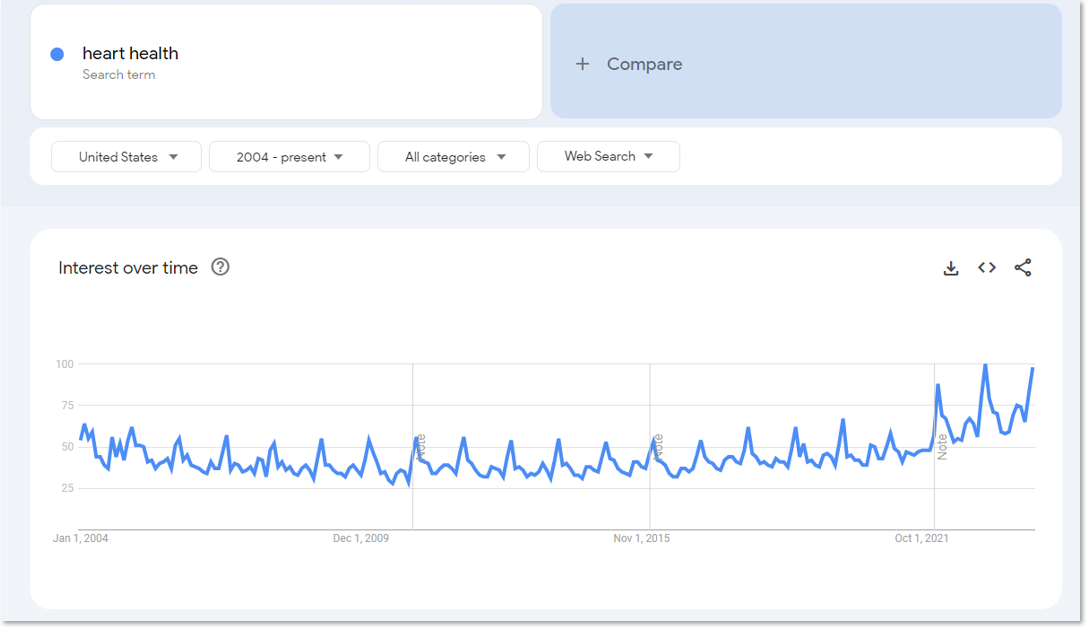We’ve written before about how crucial healthcare blogs can be to your organization’s messaging and outreach strategies. However, it’s not enough just to have a blog. Your team also has to contribute to it regularly.
You likely should be posting at least once a week. But that number may be higher if you’re in a high-competition marketplace or you need to build up your blog content. Depending on the size of your marketing team, one high-quality blog article a week could be a big ask. So how do you get the topics you need to create that much content?
We’ve pulled together seven strategies for how to stock your editorial calendar with the kinds of relevant article topics your healthcare organization’s consumers are asking for. Let’s walk through them.
1. Ask your subject-matter experts (SMEs)
Google’s search algorithm prioritizes content by industry authorities, including healthcare. Your marketing team should be ghostwriting your healthcare blog articles that will appear with those SMEs’ bylines. That means it’s only logical to ask those SMEs what they’d like the articles with their bylines to cover.
Make sure to emphasize that these are consumer-facing articles for people who may not have very high health literacy. These should not be topics geared toward an academic, researcher or provider audience. However, if your experts are taking part in research whose results you can gear toward a layperson audience, that can be a great way to showcase the expertise your organization brings to the communities you serve.
If your experts need help brainstorming ideas, try asking the following questions:
- Are there any topics you’re constantly having to educate patients/members about that you’d like to be able to simply point them to on the website?
- Are there any topics that get a lot of interest when you talk about them with family members or friends outside healthcare?
- Are there any new developments in your area of specialty that a general audience would find interesting?
Health tips are a great option to help your provider SMEs dip their toes in the waters of healthcare blogs. These tend to be evergreen articles that stand up over many years (meaning high potential for republishing — more on that below). And they can be high-performing areas of interest for your organization’s website. For example, one of our clients had an article on preparing for a colonoscopy. This article routinely had some of the highest numbers for visitor traffic and engagement throughout a site with tens of thousands of pages. Not only did it serve as a helpful resource for current patients, but this client’s strong call-to-action (CTA) strategy led to the article being a powerful source of conversions for the organization’s gastrointestinal service line as well.
2. Ask your healthcare consumers
It’s essential to source some of your healthcare blog’s topics from consumers in your service region. If you have a patient or member advisory group, that’s a great place to start. You could ask members to brainstorm collectively at a group meeting or schedule individual exploratory interviews with them to generate ideas.
But you should also consider widening your search. Set up short anonymous surveys, such as through SurveyMonkey, to ask people in your geographic area and/or from your desired demographics about what kinds of articles they’d like to see. The results could prompt additions to your list of topics that you and your team didn’t realize would be popular among your potential audience members.
3. Find healthcare controversies to refute
As a society, one of our favorite things to do is watch when someone is proven wrong. It’s basically a spectator sport. And there’s no reason your organization can’t capitalize on that for your healthcare blog.
Keep an eye out for myths, fake news, factoids spreading on social media and other sources of misinformation that are wrong about something your organization’s experts can speak against. Then cue up the right SME from your organization, and let it rip — respectfully, of course.
Make sure you’re within your lane. You want to cultivate a reputation of trust and respect in your service area for your SMEs. If it’s not healthcare-related, it’s probably best for your team to leave the issue to someone else.
As we’ve noted, the healthcare industry is having a bit of a crisis of mistrust among consumers. Healthcare blogs that cover these sorts of topics give your experts a chance to correct the record. And they can establish themselves as trusted sources of truth. What’s more, you can position your organization as a helpful resource for consumers.
4. Drum up interest in your classes, support groups, and events
Many of our clients offer various types of outreach programs and other events in their communities. But it’s easy for these to become buried in their websites’ specified sections for classes and events. And these areas often don’t see as much user interest as service-line content and other areas of their websites with high traffic and engagement. Healthcare blogs give you another avenue to reach consumers who may not have heard your message yet.
Consider incorporating your classes and events content with your health and wellness content where appropriate. Dig into why consumers should be interested and — more importantly — what value this type of event can bring to the consumer’s life. Use a link to register for the class or event as your CTA. Then start incorporating the new article in your calendar of evergreen topics to push on social media or in your e-newsletter campaigns. And you can continue to generate blog content afterward with follow-ups, participant reactions and more to help you build excitement for the next event.
5. Search social media and the news
Speaking of social media, social media pages are a great place to source potential topics of interest for healthcare blogs. What sorts of posts are your audience members reacting to on your pages? And on competitors’ pages, are there posts with lots of likes, responses or other engagements that you can put a fresh spin on?
News outlets, both specific to your service area and those covering larger footprints, are another rich source of potential topics for your healthcare blog articles. These are especially good for rapid response articles. These pieces react to breaking news and can help set up your organization as a trusted resource for healthcare-related information.
6. Tie into healthcare awareness months
In a study published in 2021, researchers noted more than 300 health awareness campaigns worldwide during that year. It may seem cliché, but there is a certain amount of expectation of content about specified healthcare topics during “National _______ Day” or “Annual _______ Month” events. The study noted “online activity outcomes were, with only a few exceptions, positively impacted by awareness days, weeks, and months.”
We can see this for ourselves, thanks to Google Trends. For example, if you look at search trends for the term “heart health” dating back to 2004, you’ll see a chart like this:

Google Trends data for the term “heart health,” 2004 to present
Each of the sharp upticks in online interest for the term “heart health” coincides with February — which the president proclaims each year as American Heart Month. So we can see that the interest is real. And that means there’s potential for you to take advantage of this interest.
These sorts of events lend themselves well to healthcare blogs that tie into period-specific email campaigns, social media campaigns, e-newsletter campaigns and so on. Just be aware that your competitors will be doing the same thing. Make sure your team members are writing with SEO best practices in mind to help your content rise above the pack.
Related: Healthcare Writing Training: 5 Ways Your Content Team Can Benefit
7. Revisit your past healthcare blogs
Once you publish a new blog article, you probably push it heavily for the first few weeks with featured positioning on your website and social posts in your various channels. Over time, these promotional efforts fall off as the focus turns to newer, more timely pieces. And that’s fine! That’s how blog articles are supposed to work — though you should remember to incorporate those evergreen pieces into your regular lineup of promotional efforts or to help cover light days for posting.
However, those older articles that have fallen off the radar are likely still strong sources of information for your consumers. They just need help finding those resources. So we recommend regularly reviewing your articles from the past couple of years to see if they would lend themselves to republication.
If the information in a blog article is still good, but your web analytics data shows the page doesn’t get much traffic, republish a new version of the article, and redirect the old URL to the new one. You should also add an editor’s note saying the article has been republished.)
If the information in the article is no longer accurate (due to advances in medical research, service/policy changes at your organization, etc.), write an updated version of the article, and include an editor’s note saying you’ve updated the original piece. Then include a link back to the old version in the note.
We also recommend regular republication of articles that are specific to specific seasons, such as:
- How to prepare for spring allergies
- Medicare renewal time
- Staying safe in winter weather
Your best healthcare blog idea: Find a strong partner
Sourcing enough article ideas to keep your healthcare blog fresh and performing can be a tough task. If you need help from industry professionals who know the ins and outs of healthcare blog strategy, we’re ready to help. Our team members will work with you at every step, from ideation and writing to planning your editorial calendar and more. Contact us to learn how we can help you succeed with your organization’s blogging efforts.

